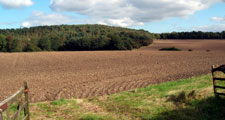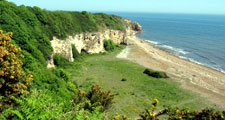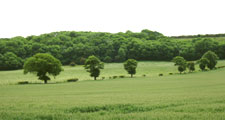Woodland in East Durham Limestone Plateau
Existing Woodland
Trees and woodlands are sparse in the open landscape of the East Durham Plateau. Small semi-natural woods and larger areas of scrub are found on the steeper slopes of escarpment vales and spurs. Larger semi-natural woodlands are found in the denes of the coastal plateau. Exposure and salt-laden winds limit tree growth elsewhere on the coast. Inland there are localised concentrations of deciduous and mixed plantations in areas of parkland and planned estate landscapes.
Native Woodland
Lowland ash woods and localised pockets of yew woodland are found on thin soils over limestone in denes and steeper escarpment slopes. Lowland oak woodlands are less common but were probably more widespread in the past on the neutral boulder clays that cover the limestone in most areas. Small pockets of free draining glacial sands and gravels may have supported areas of lowland oak-birch communities. Alder carr woodlands are found on wet fertile soils on the margins of ponds and wetlands. Secondary semi natural woodland and scrub communities are typical of derelict land, old railway lines and quarries and unmanaged limestone grasslands on the escarpment and coast. This is highly variable in structure and usually dominated by pioneer species like birch, sycamore, ash, rowan, hawthorn, gorse and dogrose. On wetter ground goat willow and grey willow are common. Scrub on the limestone is often dominated by hawthorn or gorse, or by blackthorn on the coast, but more diverse scrub containing a wide range of rose and shrub willow species is also characteristic. Isolated clumps of juniper scrub occur on the coast, and were more extensive in the past.
Characteristic native woodland types in the Wear Lowlands (identified here by their National Vegetation Class) include:
- Lowland Ash Woodland – NVC W8
- Lowland Oak Woodland – W10
- Lowland Oak Birch Woodland – W16
- Alder Carr Woodland – W5
- Yew Woodland – W13
- Juniper Woodland – W19
- Hawthorn Scrub – W21
- Blackthorn Scrub – W22
- Gorse Scrub – W23
- Bramble Scrub – W24/25
Information on the typical structure and species composition of these particular native woodland communities, distribution and guidelines on their management, and suitable sites for new planting can be found by clicking on the links above or by downloading the following pdf:
Native Woodland Types (PDF, 598kb)
Native woodlands in the East Durham Plateau occur as isolated fragments and some have been modified by the planting of exotic or commercial species. Dutch Elm disease has altered the structure of many woods, with sycamore often replacing the native wych elm in the canopy. Some are managed by conservation bodies under WGS contracts; others receive no active management.
Objectives for the area’s existing native woods include:
- Conserving and restoring semi-natural woodlands.
Plantations
Plantations are relatively scarce on the East Durham Plateau though there area localised concentrations associated with parkland and estate landscapes laid out in the 18th century and 19th centuries. Most plantations from this period have been felled and replanted more than once in their history although some older trees survive. They are often composed of broadleaved species such as beech, sycamore, oak and ash, or mixtures including conifers, particularly scots pine and larch. Exotic conifers and hardwoods are often present in the more ornamental woodlands and copses of parklands. A number of limestone denes contain softwood plantations and there are some substantial plantations of conifers in the Wingate area. Younger plantations of conifers and native or exotic broadleaved species, often narrow shelterbelts and small copses, are a common feature of reclaimed colliery land and land filled quarries.
Some plantations in the area are managed under Woodland Grant Scheme contracts but take-up is very variable – many receive little active management due to the current economics of forestry.
Priorities for the area’s plantations include:
- Progressive conversion of some softwood plantations to native woodland – and particularly those on replanted ancient woodland sites, in limestone denes, and sites close to ancient woods to expand the native woodland habitat resource.
- Increasing the proportion of native broadleaved species in softwood plantations – and particularly along watercourses, margins and rides.
New Woodland
Planting Sites
Priorities for new planting in the East Durham Plateau identified in the Landscape Strategy include:
Creating new native ash and oak woodlands and particularly where they would contribute to wildlife goals – for example by extending or linking isolated ancient woods on the escarpment and in coastal denes. Creating new wet woodlands on poorly drained land of the Clay plateau.
Existing semi-natural woods survive in this landscape as isolated fragments and the plant communities within them are often strongly related to the underlying limestone which itself outcrops in a fragmented pattern other than along the escarpment. On thin soils over limestone – typical of the escarpment – there are often conflicting priorities for habitat creation, and particularly the restoration of magnesian limestone grassland. There may be opportunities to plant new ash woodlands on the scarp in association with grassland restoration scheme. There may also be merit in seeking to increase woodland connectivity by planting oak and ash woodlands on the mosaic of limestone and drift east of the scarp where nature conservation sensitivities are lower. Conflicts with grassland habitat creation priorities also occur in the coastal denes, but are less acute where the denes cut down through base-poor drift rather than limestone: woodland creation is a clearer priority here. The poorly drained clays of the clay plateau offer opportunities to create wet woodlands in association with existing wetlands.
To increase woodland cover generally, and particularly in the urban fringe and along major transport corridors.
The coalfield landscape of the East Durham Plateau is a priority area for new woodland planting generally due to its legacy of environmental degradation and proximity to urban populations. While some parts of the landscape are currently very open in character, the landscape as a whole is generally robust and heterogeneous. It contains some heavily wooded areas as well as areas heavily influenced by urban and industrial development where new planting would strengthen landscape character by helping to screen, contain and assimilate built development. This is particularly true in areas around major industrial estates, road corridors (the A19 for example) and active limestone quarries. There are areas where the historic character of the landscape has been weakened by agricultural intensification – particularly through the loss of field boundaries. The development of new woodlands here would help to create new and attractive landscapes – albeit very different from those of the past. There are some sensitivities in the landscape – sites of nature conservation or historical interest in particular – but many sites are generally suitable for new woodland planting.
Creating new community woodlands close to towns and villages.
The East Durham Plateau is heavily populated and many towns and villages have little access to woodland or natural green space. Planting community woodlands close to urban populations can provide an important recreational resource for local people as well as improving the appearance of the urban fringe environment.
To restore derelict land and improve the landscape of reclaimed land by planting native woodlands.
Pockets of derelict land occur across the East Durham Plateau. Some have nature conservation sensitivities. Planting new native woodlands as part of their reclamation can help restore them to a beneficial use and assimilate them into the wider landscape.
Creating new woodlands in the restoration of mineral workings.
In the restoration of limestone quarries there are often conflicting priorities for habitat creation, and particularly the restoration of magnesian limestone grassland which is an important BAP priority habitat. There are circumstances where it is appropriate to develop new ash and yew woodlands as part of quarry restoration and particularly where this helps to screen or assimilate the quarry into the local landscape.
Developing areas of woodland and scrub in cliff top denes or as screening for nearby development.
The coast is currently very open in character and, as with other parts of this landscape, there are often other priorities for habitat creation – particularly maritime grassland. The development of woodland and scrub habitats can be complimentary to those goals and help to create a more visually diverse and naturalistic coastal environment, and particularly in the shelter of cliff-top denes, and where they could help screen settlement edges, allotment gardens and industrial development,
Planting Design
On the scarp and the coastal limestone plateau new woodlands should follow the topography, of steep slopes, incised denes and dry valleys. Elsewhere woodland edges should respond to, and interlock with, field patterns where these are strong. On the coast, planting design should be naturalistic, responding to the topography and forming mosaics with open grassland at varying planting densities.
Species Selection
Many of the priorities for new woodland planting are for new native woodlands. For these, existing native woodland types can be used as a guide to species selection.
The East Durham Plateau contains a broad range of soils from calcareous brown earths to heavy gleys which support very different plant communities. It is likely that on the base poor soils that cover much of the area, lowland oak woodlands (NVC W10) would be the best models for new planting with lowland ash woodlands (NVC W8) on base rich soils over limestone. In many areas a mosaic of the two reflecting ground conditions would be more appropriate. In some circumstances – particularly on exposed limestones in abandoned quarries – Yew Woodland (NVC W13) might be established. On less fertile sites, and in particular colliery shales, oak-birch woodlands (NVC W16) may provide useful models although these are not strongly characteristic of the area. On road verges, limestone quarries and coastal areas the development of scrub, dominated by hawthorn or blackthorn may be more appropriate than woodland. Alder woodlands may be useful models for planting on wet ground within other woodlands (NVC W7), or in association with wetland features (NVC W5).
On the better soils of the Plateau opportunities may exist for the production of good quality hardwoods with planting mixtures designed for silvicultural purposes. Where possible these should use the native broadleaved species found in the semi-natural woodlands associated with the plateau landscape.
Further Information
View an interactive map of the distribution of Native Woodland Types in County Durham.



